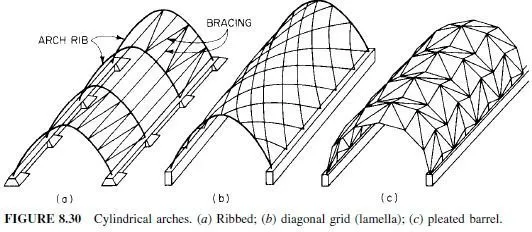Supports of crane girders must be capable of resisting static and dynamic horizontal and vertical forces and stress reversal. Consequently, heavily loaded crane girders (for cranes with about 75-ton capacity or more) usually are supported on columns carrying no other loads. Less heavily loaded crane girders may be supported on building columns, which usually extend above the girders, to carry the roof.
It is not advisable to connect a crane girder directly to a column. End rotations and contraction and expansion of the girder flanges as the crane moves along the girder induce severe stresses and deformations at the connections that could cause failure. Hence, vertical support should be provided by a seat, and horizontal support by flexible connections. These connections should offer little restraint to end rotation of the girders in the plane of the web but should prevent the girders from tipping over and should provide lateral support to the compression flange.
When supported on building columns, the crane girders may be seated on brackets (very light loads) or on a setback in those columns. (These arrangements are unsatisfactory for heavy loads, because of the eccentricity of the loading.) When a setback is used, the splice of the deep section and the shallow section extending upward must be made strong. Often, it is desirable to reinforce the flange that supports the girder.
Whether seated on building columns or separate columns, crane girders usually are braced laterally at the supports against the building columns. In addition, when separate columns are used, they too should be braced at frequent intervals against the building columns to prevent relative horizontal movement and buckling. The bracing should be flexible in the vertical direction, to avoid transfer of axial stress between the columns.
Figure 5.71 shows the connection of a crane girder supported on a separate column. At the top flange, horizontal thrust is transmitted from the channel through a clip angle and a tee to the building column. Holes for the fasteners in the vertical leg of the clip angle are horizontal slots, to permit sliding of the girders longitudinally on the seat. The seat under the bottom flange extends to and is attached to the building column. This plate serves as a flexible diaphragm. Stiffeners may be placed on the building column opposite the top and bottom connections, if needed. Stiffeners also may be required for the crane-girder web. If so, they should be located over the flanges of the crane-girder column.




